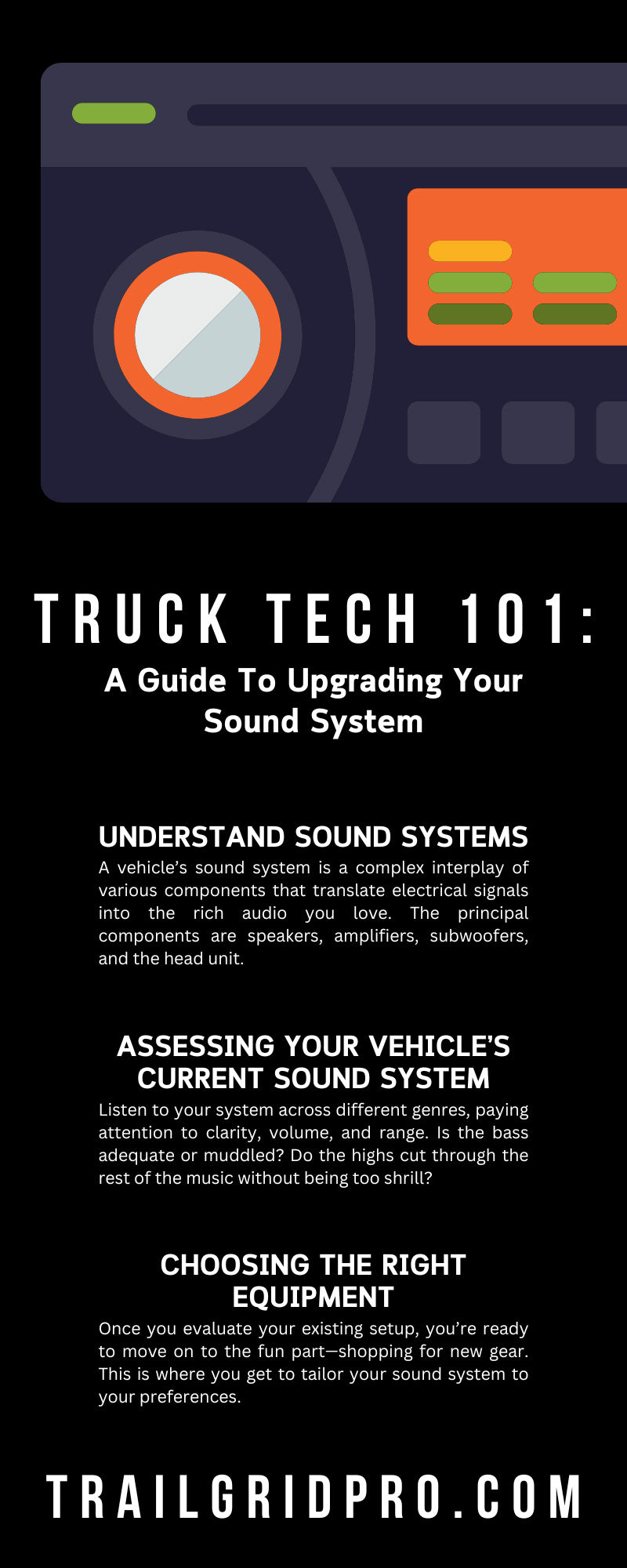For many truck enthusiasts, the auditory component is a crucial part of any driving experience. Whether you’re listening to your favorite playlists on a road trip or need a fast-paced soundtrack for your off-roading excursions, the quality of your truck’s sound system can make or break your journey. Explore this guide to delve into the world of sound upgrades for your truck. From identifying your current system specifications to making a DIY upgrade, this comprehensive guide has everything to get you started. Find out how to transform each driving experience into a concert featuring all your favorite artists.
Understand Sound Systems
Before you can crank up the volume, it’s crucial to understand how your vehicle’s sound system works. A vehicle’s sound system is a complex interplay of various components that translate electrical signals into the rich audio you love. The principal components are speakers, amplifiers, subwoofers, and the head unit. Each of them plays a role in delivering a full spectrum of sound, from the lowest bass notes to the highest trebles.
- Speakers: Your primary link to the system, speakers convert the amplified signals into sound. They turn the voltage from the amplifier into the vibrations that reach your ears.
- Amplifiers: These components provide the necessary power to the speakers, taking low-voltage audio signals from your head unit and boosting them to a level that can produce clear and loud sound.
- Subwoofers: Subwoofers handle low-frequency sounds, bringing depth and intensity to your music. This component affects how you hear genres such as rap, techno, and certain types of rock that rely heavily on the bass.
- Head unit: Commonly known as the stereo or deck, the head unit is command central. It controls audio sources, houses the CD or MP3 player, sometimes includes a touch screen for various applications, and allows you to tune into radio signals.
Assessing Your Vehicle’s Current Sound System
The first step in the upgrade process is to take stock of what you already have. Listen to your system across different genres, paying attention to clarity, volume, and range. Is the bass adequate or muddled? Do the highs cut through the rest of the music without being too shrill? Which levels do you want to bring out the most to suit the type of music you listen to on your journeys?
Next, consider the age and condition of your audio components. Over time, speakers can blow out, exhibit distorted sound, or degrade in quality. Amplifiers may also malfunction, affecting the overall performance. Identify these issues, and you’ll clearly understand where to focus during your sound upgrade.
Choosing the Right Equipment
Once you evaluate your existing setup, you’re ready to move on to the fun part—shopping for new gear. This is where you get to tailor your sound system to your preferences. When selecting new equipment, consider the following factors.
- Compatibility: Ensure your chosen components are compatible with each other and your truck model. Modern sound systems often interact with other vehicle functions, so a little research can save you a lot of headaches.
- Power: Don’t overlook the power ratings. Match your new speakers’ and amplifiers’ power to avoid damaging your gear or producing a subpar sound.
- Budget: High-end systems with top-of-the-line equipment and custom installations can be costly, but you can achieve excellent quality and performance at various price points. Set a budget and strive to get the best value within your financial constraints.
If you’re looking for a convenient place to shop for Toyota Tacoma parts, including sound systems that match your model, start at Trail Grid Pro. We offer high-quality, affordable sound systems that any car enthusiast can install themselves. While we offer step-by-step installation guides, it’s also important to have a general idea of the process. Keep reading to learn more about sound system installation.
Sound System Installation Process
With your shiny new components, it’s time to explore the installation process. If you’re a seasoned DIYer, you should feel confident tackling this job on your own. However, you can also seek professional help, especially when dealing with your truck’s electrical system.
Do-it-yourself enthusiasts can use this basic guide to understand the installation process.
Preparing the Vehicle
Disconnect the battery before installation to avoid electrical mishaps. Carefully read the instruction manuals for all the equipment you’re installing.
Mounting and Wiring the Components
Mount the new speakers, amplifier, and subwoofers in their designated locations. Wiring can be time-consuming, but neatly bundling your wires is crucial to avoid electrical interference or unwanted noise in your system.
Connecting Everything
Be meticulous about connecting the wires to the right terminals and securing them firmly. Pay special attention to the grounding wire, as it can significantly influence your system’s performance.
Testing the System
Before you bolt everything back together, connect the battery and test your newly installed sound system. This step will allow you to identify and correct any issues immediately.
How To Fine-Tune and Test Your System
The installation is complete, but your job is not yet complete. The beauty of a personalized sound system is the control it gives you over your audio experience. Spend time tweaking the settings on your head unit—adjust the bass, treble, balance, and fade to achieve a sound that matches your preferences and the acoustics of your cabin.
Testing is also critical. Take your truck for a drive and pay attention to the finer details of the sound. You may need to go back and forth, adjusting settings and placements, until you achieve the perfect balance.
Sound System Maintenance and Troubleshooting
Your new and improved sound system will need care to keep it in top shape. Perform regular maintenance, such as cleaning the components and checking connections for rust or damage. Protect your system from environmental factors and extreme temperatures, which can lead to premature wear and tear.
Understanding common issues such as speaker distortion, amplifier overheating, or bad wiring can help you troubleshoot effectively. Keep a log of the changes you make to your system and note what works and what doesn’t for future reference.
Upgrading your truck’s sound system is a rewarding experience, especially if you put in the work to complete it yourself. You’re not just enhancing your vehicle; you’re personalizing your driving experience. The investment you make in quality equipment, thoughtful installation, and careful tuning is one that will pay off on your adventures.
Don’t settle for stock sound systems and sub-par sound quality when it comes to your prized vehicle. Use this guide on how to update your sound system and our step-by-step guides here at Trail Grid Pro to give your vehicle the superior sound quality it deserves.


